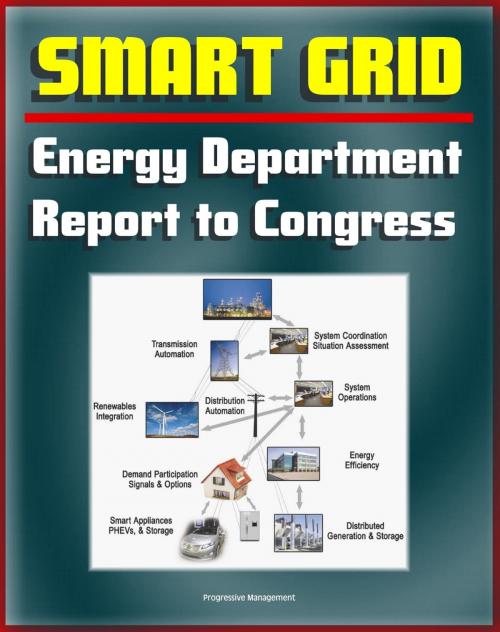2012 Smart Grid System Report to Congress: Smart Electric Meters, Renewables Integration, Electric Cars and Vehicles, Transmission Automation, Grants and Programs, Cyber Security, Energy Efficiency
Nonfiction, Science & Nature, Technology, Electricity, Power Resources| Author: | Progressive Management | ISBN: | 9781476461441 |
| Publisher: | Progressive Management | Publication: | May 10, 2012 |
| Imprint: | Smashwords Edition | Language: | English |
| Author: | Progressive Management |
| ISBN: | 9781476461441 |
| Publisher: | Progressive Management |
| Publication: | May 10, 2012 |
| Imprint: | Smashwords Edition |
| Language: | English |
This comprehensive energy department report presented to Congress in February 2012 (and dated for the 2010 reporting period) provides unique insight into the ongoing effort to update and modernize America's electric utility system. A smart grid uses digital technology to improve the reliability, security, and efficiency of the electricity system, from large generation through the delivery systems to electricity consumers. Smart grid deployment covers a broad array of electricity system capabilities and services enabled through pervasive communication and information technology, with the objective of improving reliability, operating efficiency, resiliency to threats, and our impact on the environment.
Contents: Executive Summary * Acronyms and Abbreviations * 1.0 Introduction * 1.1 Objectives * 1.2 Scope of a Smart Grid * 1.3 Stakeholder Landscape * 1.4 Regional Influences * 1.5 What's New in this Report * 1.6 About This Document * 2.0 Deployment Metrics and Measurements * 2.1 Smart Grid Metrics * 2.2 Smart Grid Characteristics * 2.3 Mapping Metrics to Characteristics * 3.0 Deployment Trends and Projections * 3.1 Enables Informed Participation by Customers * 3.1.1 Grid-Enabled Bi-Directional Communication and Energy Flows * 3.1.2 Managing Supply and Demand * 3.2 Accommodating All Generation and Storage Options * 3.2.1 Distributed Generation and Storage * 3.2.2 Standard Distributed-Resource Connection Policy * 3.3 Enables New Products, Services, and Markets * 3.3.1 Enabling New Products and Services * 3.3.2 Enabling New Markets * 3.4 Provides Power Quality for the Range of Needs * The Cost of Poor Power Quality * Smart Grid Solutions to Power Quality Issues * 3.5 Optimizing Asset Utilization & Operating Efficiency * 3.5.1 Bulk Generation * 3.5.2 Delivery Infrastructure * 3.5.3 Distributed Energy Resources * 3.5.4 Overall System Efficiency * 3.6 Operates Resiliently to Disturbances, Attacks, & Natural Disasters * 3.6.1 Area, Regional, National Coordination * 3.6.2 DER Response Metrics * 3.6.3 Delivery Infrastructure Metrics * 3.6.4 Secure Information Networks * 4.0 Challenges to Deployment * 4.1 Technical Challenges * 4.2 Business and Financial Challenges * 5.0 Recommendations for Future Reports * 6.0 Conclusions * 6.1 Progress towards Realizing the Characteristics of the Modern Grid * 6.2 Challenges to Smart Grid Deployments * 6.3 Recommendations for Future Reports * 7.0 References.
Significant challenges to realizing smart grid capabilities persist. Foremost among these are the challenges tied to the value proposition and the capital required to purchase the new technologies envisioned for communicating information between end-users, energy providers, and distribution and transmission providers. These and other challenges are explored in this report.
The DOE states: Our current electric grid was built in the 1890s and improved upon as technology advanced through each decade. Today, it consists of more than 9,200 electric generating units with more than 1 million megawatts of generating capacity connected to more than 300,000 miles of transmission lines. Although the electric grid is considered an engineering marvel, we are stretching its patchwork nature to its capacity. To move forward, we need a new kind of electric grid, one that is built from the bottom up to handle the groundswell of digital and computerized equipment and technology dependent on it—and one that can automate and manage the increasing complexity and needs of electricity in the 21st Century.
This comprehensive energy department report presented to Congress in February 2012 (and dated for the 2010 reporting period) provides unique insight into the ongoing effort to update and modernize America's electric utility system. A smart grid uses digital technology to improve the reliability, security, and efficiency of the electricity system, from large generation through the delivery systems to electricity consumers. Smart grid deployment covers a broad array of electricity system capabilities and services enabled through pervasive communication and information technology, with the objective of improving reliability, operating efficiency, resiliency to threats, and our impact on the environment.
Contents: Executive Summary * Acronyms and Abbreviations * 1.0 Introduction * 1.1 Objectives * 1.2 Scope of a Smart Grid * 1.3 Stakeholder Landscape * 1.4 Regional Influences * 1.5 What's New in this Report * 1.6 About This Document * 2.0 Deployment Metrics and Measurements * 2.1 Smart Grid Metrics * 2.2 Smart Grid Characteristics * 2.3 Mapping Metrics to Characteristics * 3.0 Deployment Trends and Projections * 3.1 Enables Informed Participation by Customers * 3.1.1 Grid-Enabled Bi-Directional Communication and Energy Flows * 3.1.2 Managing Supply and Demand * 3.2 Accommodating All Generation and Storage Options * 3.2.1 Distributed Generation and Storage * 3.2.2 Standard Distributed-Resource Connection Policy * 3.3 Enables New Products, Services, and Markets * 3.3.1 Enabling New Products and Services * 3.3.2 Enabling New Markets * 3.4 Provides Power Quality for the Range of Needs * The Cost of Poor Power Quality * Smart Grid Solutions to Power Quality Issues * 3.5 Optimizing Asset Utilization & Operating Efficiency * 3.5.1 Bulk Generation * 3.5.2 Delivery Infrastructure * 3.5.3 Distributed Energy Resources * 3.5.4 Overall System Efficiency * 3.6 Operates Resiliently to Disturbances, Attacks, & Natural Disasters * 3.6.1 Area, Regional, National Coordination * 3.6.2 DER Response Metrics * 3.6.3 Delivery Infrastructure Metrics * 3.6.4 Secure Information Networks * 4.0 Challenges to Deployment * 4.1 Technical Challenges * 4.2 Business and Financial Challenges * 5.0 Recommendations for Future Reports * 6.0 Conclusions * 6.1 Progress towards Realizing the Characteristics of the Modern Grid * 6.2 Challenges to Smart Grid Deployments * 6.3 Recommendations for Future Reports * 7.0 References.
Significant challenges to realizing smart grid capabilities persist. Foremost among these are the challenges tied to the value proposition and the capital required to purchase the new technologies envisioned for communicating information between end-users, energy providers, and distribution and transmission providers. These and other challenges are explored in this report.
The DOE states: Our current electric grid was built in the 1890s and improved upon as technology advanced through each decade. Today, it consists of more than 9,200 electric generating units with more than 1 million megawatts of generating capacity connected to more than 300,000 miles of transmission lines. Although the electric grid is considered an engineering marvel, we are stretching its patchwork nature to its capacity. To move forward, we need a new kind of electric grid, one that is built from the bottom up to handle the groundswell of digital and computerized equipment and technology dependent on it—and one that can automate and manage the increasing complexity and needs of electricity in the 21st Century.















